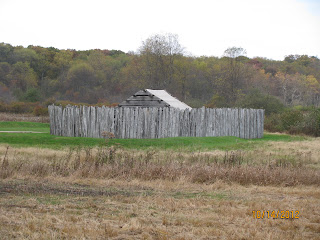Sunday's adventure continued after Fallingwater as I headed back south through Ohiopyle, PA. Ohiopyle is a very small community of about 77 people. It barely registers on the map. Now imagine my surprise when I enter Ohiopyle to find it full of hundreds of people. Turns out that despite its small size and population, it is a major hub for whitewater rafting, kayaking, hiking, cycling, and camping. According to a promotional brochure, 14 miles of the Youghiogheny River pass through the small town, which seems to be an awful lot. Any which way, it looked positively awesome and will be a weekend destination come spring next year.
My next stop was Fort Necessity National Battlefield. Fort Necessity is known as the site of the first battle in which George Washington participated. I had in my mind a fort similar to those the French built along the Mississippi River during the same time period, but was greatly mistaken. As you can see from the photos below, the fort was incredibly small. It consisted of a sole storehouse structure surrounded by a palisade, which was primarily to keep Washington's own men from getting to the rum stored inside.
The area within the palisade is only a few hundred square feet. It was also crudely built, offering little protection from attackers.
Very small cannon mounted on posts aided the defenders. In the background, you can see part of the earthenworks that served as the fort's primary fortification.
The crudely built storehouse with a canvas roof housed the powder, shot, rum, and flour that sustained the garrison.
About a third of a mile up the ridge from the fort is the Mount Washington Tavern, my next stop. I decided to hike over to it up a steep incline. The tavern was once a major stop along the National Road, our first federally funded highway. The tavern dates to the 1830s, twenty years after the National Road originally opened to traffic. The tavern has been restored to serve as a museum, and is furnished with period pieces meant to depict the standard features of a tavern/inn of the time.
The stately brick building has been modified somewhat over the years, as can be seen by the difference in the brick along the side wall. The front rooms did not originally exist in the 1830s.
The tavern was built on land that George Washington purchased in 1770, hence its name.
One of the first floor rooms was the bar, where travelers would knock back a few before heading upstairs to one of the rooms like that below.
To fit as many guests in as possible, the tavern owners crammed as many beds as possible into each room. Some rooms had up to four beds.
I finished my trip by taking US 40 (the old National Road) west to Uniontown, PA for some lunch, then headed south back to Morgantown. The weather was beautiful for the trip. Hopefully I'll have another opportunity this year to get up into Pennsylvania for another round of sightseeing before the weather turns bad. Stay green, my friends!







No comments:
Post a Comment